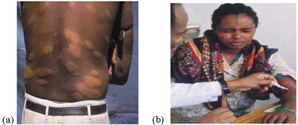18.4.1 Checklist for examination of the skin
- Ask the person to remove all his/her clothes/garments.
- Examine the skin under adequate light and ensure privacy for the person to feel at ease.
- Examine the person systematically from the head to toe. Examine the front side of the body first and then examine from the back.
- Examine, count and record the presence of skin lesions; look for pale or reddish discoloration of the skin (see Figure 18.3a).
- Examine for loss of sensation in the skin lesions by rolling the end of a wisp of cotton into a fine point and explaining to the person the purpose of the test is for him/her to point to the spot where he/she feels the touch of the cotton wool. Then touch the skin patch lightly until the cotton wisp bends, first of all while the person has his/her eyes fully open and wait for the reaction of the person to the touch.
- Now repeat the test when the person’s eyes are closed (see Figure 18.3b). If the person points away from where the skin is tested, the skin patch has no sensation and the suspect is probably a case of leprosy. If he/she points accurately to the spot or near the spot where you touched the skin patch with the cotton wisp, and if there are no other signs of the disease, they probably don’t have leprosy.
- Look for loss of eyebrows and/or eyelashes. These are signs of leprosy when they are not due to deliberate removal for cosmetic reasons.
Back to previous pagePrevious
18.4 Examining the person with suspected leprosy

